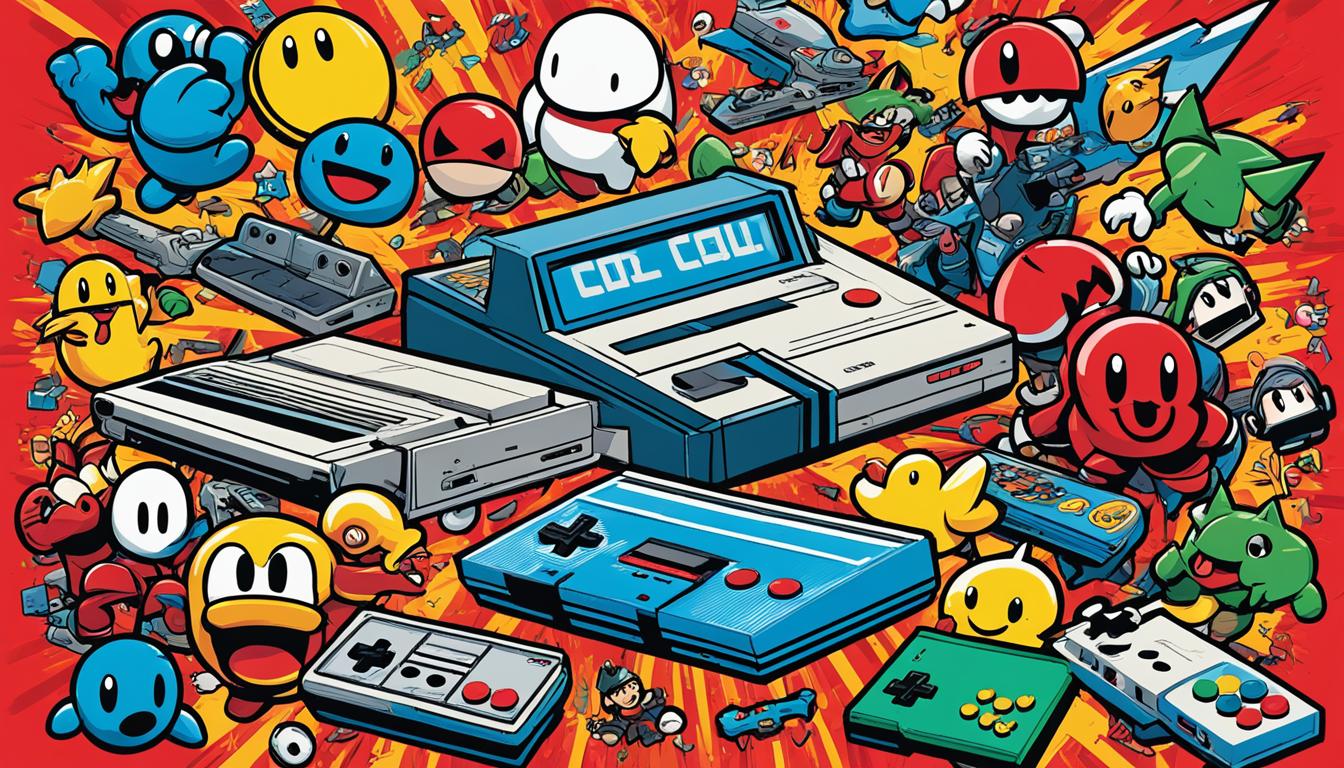Japan is a top player in the video game world. It’s known for its rich history and game contributions. In 2018, it had over 67.6 million players, making it the third largest market globally.
It’s been home to major game companies like Nintendo and Sega. These companies helped shape the golden age of video gaming. They still innovate and capture players worldwide today.
Japan loves mobile gaming, especially titles from companies like Nintendo, Sega, and Capcom. And in Japan, more people play games on their phones than on traditional gaming consoles. This has made mobile game publishers more profitable than console game publishers there.
Japanese role-playing games (JRPGs) are also very popular. Dragon Quest’s launch in 1986 ignited a love for these games among the Japanese. This trend led to the creation of famous games like Final Fantasy and Persona.
Visual novels are a unique form of game in Japan. They mix engaging stories with beautiful art. Some have become so popular that they got their own animes.
Gacha games are a hit in Japan as well. These games have a lottery system to win characters or items. They’re known for being fun and a bit addictive.
Japanese gaming has made a mark worldwide. It introduced hits like Pac-Man and NES to the global audience. Figures like Hideo Kojima have changed the game design and story landscape too.
This article will dig into Japan’s gaming history. We’ll look at how it all started, the big games and genres, and the major players. We’ll also see how it influenced the world culturally.
So stay tuned to learn more. We’ll talk about how arcades and JRPGs became so big, what makes Japanese games unique, and the importance of preserving this history.
Key Takeaways:
- Japan is considered one of the most influential countries in video gaming, with the third largest video game market globally.
- Japanese game development has given rise to major video game companies like Nintendo and Sega.
- Mobile gaming and Japanese role-playing games (JRPGs) have gained significant popularity in Japan.
- Visual novels and gacha games are unique genres that have captivated players in Japan.
- The impact of Japanese gaming extends globally, with Japanese games and developers leaving a lasting mark on the industry.
Arcade Culture and Influence.
Arcade culture is a big part of Japan’s gaming history. It has left a mark with famous game titles and special gaming areas.
Akihabara Electric Town in Tokyo, Japan, is a key spot. It’s lively with not only arcades but also shops selling anime, manga, and video games. This area is perfect for fans who love these things.
Games from Japan often become popular all over the world. For example, Super Mario and Pokémon are adored by many. They show off the talent and originality of Japanese game makers.
Japanese arcade machines have also changed the gaming world. In 1966, Sega’s Periscope set a new standard by costing a quarter to play. Later, Gun Fight used new technology, making big waves. Sega’s Heavyweight Champ then brought fighting to video games in 1976.
This part of Japan’s gaming history owes a lot to companies like Taito and Namco. They embraced arcade games early, helping these fun spots grow in popularity across Japan.
Japanese arcade culture is still loved today, offering a special gaming joy to fans worldwide.
| Notable Japanese Arcade Games | Release Year |
|---|---|
| Periscope | 1966 |
| Gun Fight | 1975 |
| Heavyweight Champ | 1976 |
Gaming Platforms.
In the world of Japanese gaming, various platforms have led the way. They have offered fun for millions, from classic arcades to modern mobile games. Japan is a hub of gaming creativity and innovation, drawing players in.
Arcade Machines: The Heart of Japanese Gaming
Arcade machines have been key in Japanese gaming history. These loud, bright machines have kept players entertained and connected for years. Places like Akihabara Electric Town are known worldwide for their arcades, where gamers gather to enjoy the latest.
Games like Sega’s Periscope changed everything when it arrived in 1966. This game, based on a submarine theme, became a huge hit. Its success in Japan, Europe, and North America marked the start of arcade gaming’s worldwide fascination.
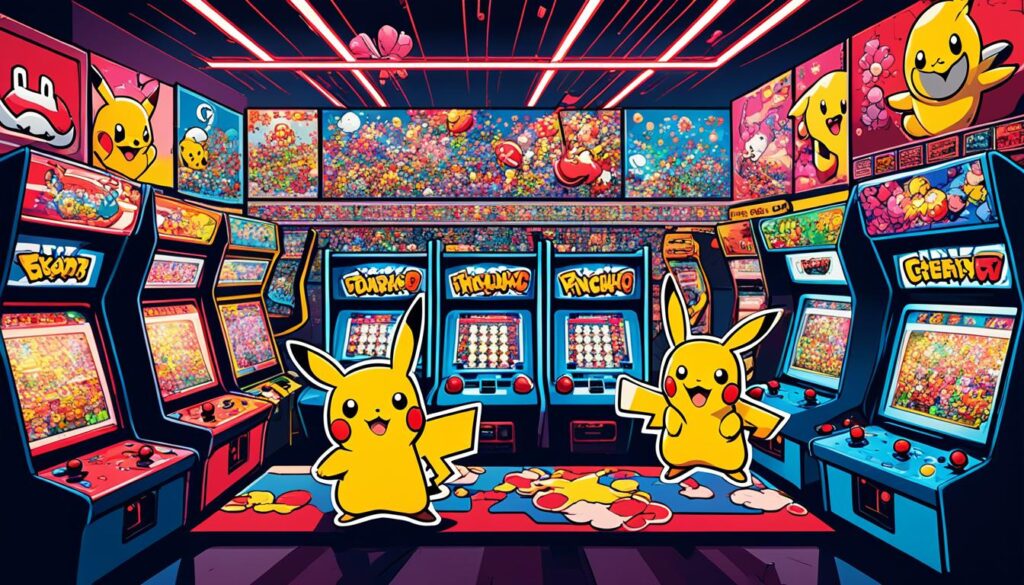
Mobile Games: The Rise of Gaming on the Go
Mobile games are now a major part of Japan’s gaming world. With smartphones, gaming is available everywhere, all the time. In Japan, more people play on their phones than on old consoles like the PlayStation 3.
In Japan, freemium games are the biggest thing. These games are free to download and play, but players can buy items in the game. Gacha games, in which players can get random virtual goods, are quite popular. This feature makes gaming more interesting and players need to plan their spending wisely.
The Diverse Japanese Gaming Landscape
Japan’s gaming scene offers a broad range of experiences, from arcades to mobile games. It’s filled with different genres, including action, RPGs, and puzzles. This means there’s something for everyone, from competitive arcade play to story-driven mobile games.
Overall, Japan’s gaming platforms have made a big impact. Arcade machines offer a fun, social environment, while mobile games give easy access to entertainment. This has helped Japan become the third-largest game market globally, highlighting the role these platforms play.
Japanese Role-Playing Games (JRPGs).
Japanese role-playing games (JRPGs) have deeply influenced the gaming world. They come from tabletop games in the West but quickly grew to bring their style. This made them stand out.
The journey of JRPGs is exciting. It’s filled with great stories and games that draw players in. Titles like Final Fantasy and Dragon Quest are hugely popular. They are known for their deep stories and amazing game worlds.
“A Guide to Japanese Role-Playing Games” looks at the history of JRPGs from 1982 to 2020. It reviews over 600 JRPGs, giving a deep look into the genre. This book is a great read for anyone who loves JRPGs.
One cool thing about JRPGs is the variety of game types. Whether you enjoy strategy, sneaky Rogue-likes, or exploring dungeons in first person, you’ll find a JRPG for you.
| Total Pages | Cover Artwork | Contributors | Weight |
|---|---|---|---|
| 652 | A variety of fans and journalists | Approximately 2.5 kg (volumetric weight) |
This special book dives deep into the history of JRPGs. Its cover artwork uses unique inks and metallic foil. This makes it a must-have for fans.
Storytelling is a key part of what makes JRPGs stand out. Players really get into the game’s story. This makes the game world feel real to them.
From the start to their big global impact, JRPGs keep players hooked. Their detailed stories, smart play, and beautiful designs keep fans coming back. Games like Final Fantasy and Dragon Quest show Japan’s big role in the RPG world.
Visual Novels.
Visual novels are a hit in Japan. They mix good stories with beautiful art. Players can choose what happens next, affecting how the story ends. While many focus on love, some explore other topics.
Games like ‘Analogue: A Hate Story’ and ‘Sakura Spirit’ are getting popular in the West. They show how the genre keeps growing with new stories and ideas.
The idea behind visual novels started in Japan about 30 years ago. In 1992, ‘Otogirisou’ made people see them as their own type of game. It all started with adventures and led to something new.
‘Dōkyūsei’ (1992) helped create the ‘dating sim’ part of visual novels. There are games for all kinds of people, such as bishōjo for men and otome for women.
Visual novels have found fans everywhere. They bring together stories and gameplay in a special way.
The Evolution of Storytelling in Video Games
The 1980s and 1990s saw games focus more on telling stories. ‘Snatcher’ (1988) was one of the first to draw players in with its tale.
In 2006, a lot of new PC games in Japan were visual novels. They’ve stayed popular there, but not as much in other places.
One cool thing about visual novels is the way the story can change. Your choices influence the plot and what endings you can get.
| Key Features of Visual Novels | Examples |
|---|---|
| Non-linear branching storylines | ‘Clannad’, ‘Steins;Gate’ |
| Character interactions and dialogue choices | ‘Phoenix Wright: Ace Attorney’, ‘Doki Doki Literature Club!’ |
| Morality systems | ‘Fate/stay night’, ‘Undertale’ |
| Kinetic novels (non-branching plots) | ‘Umineko When They Cry’, ‘Muv-Luv Alternative’ |
Visual novels have a lot to read because of their different paths. This makes for a deep and interesting story experience.
They have influenced other game types too. RPGs like ‘Lost Odyssey’ and ‘BlazBlue’ have them to thank for some ideas.
In the West, we call many Japanese games ‘visual novels’. But some, like ‘Hotel Dusk,’ are seen as adventures more than visual novels in Japan’s eyes.
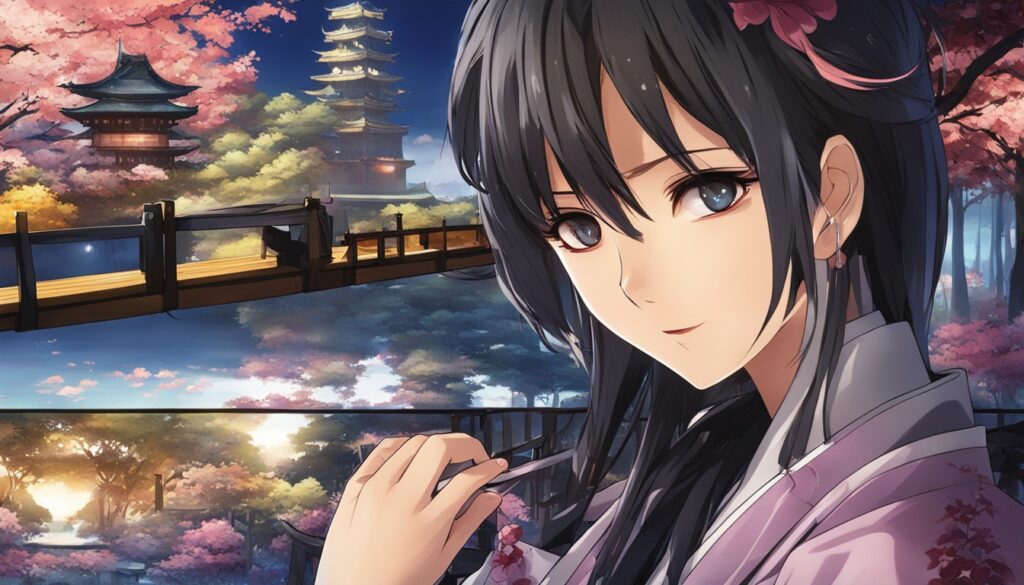
Visual novels are special in the gaming world. They tell stories in a way that hooks players from all over. With great stories and beautiful art, they keep us coming back for more.
Gacha Games.
Gacha games are a big hit in the world of Japanese gaming. They get their name from “gachapon,” which are vending-dispensed toys. In these games, players use in-game cash to get random items or characters. This model is often seen in mobile games that don’t cost anything to start playing, making them very popular.
It became well-known in the early 2010s, starting in Japan. Now, games from China, Korea, Europe, and the USA also use this approach. But, some people don’t like gacha games because they feel too much like gambling. Players can spend real money to get random stuff, which has led to worries about spending too much or being tricked into buying more.
The “near miss tactic” often employed in gacha games shows players desired rare items, creating a sense of anticipation and temptation to spend more in pursuit of those items.
Some gacha games try to reduce these worries by including a “pity” or “spark” system. This system makes it so that if you don’t get what you want after a lot of tries, you’re guaranteed to eventually get it. However, the game’s currency can be hard to earn, and that can make it tough for players to use these safety nets effectively.
Gacha games use many tricks to keep players coming back. For example, they offer rewards for logging in and completing certain tasks every day. They also use banners to show what players can win, which can get players excited or worried about not getting something before it’s gone.
Notable Japanese Gacha Games
There are many gacha games that have become big hits. Here are a few examples:
| Game | Release Year |
|---|---|
| iDOLM@STER | 2011 |
| Granblue Fantasy | 2014 |
| Fate/Grand Order | 2015 |
These games show how much variety there is in gacha games. They have different ways to play, like fighting or rhythm games, along with the excitement of collecting new things.
Even with all the debate, gacha games are still very popular and make a lot of money. Game makers like them because they bring in cash without players having to pay upfront. But it’s key to deal with issues like too much spending, the risk of gambling problems, and the stress it can put on players who can’t afford to buy a lot in games.
Gacha games are now a key part of the culture for fans of anime and manga. They’re loved for the joy of collecting, finishing sets, and making sure they get everything new before it’s gone. This has made them very big, especially in countries like China, Japan, and South Korea.
These days, gacha games are growing and changing the video game world. Some games that started in Japan have become loved all over the world. As more of these games come out, it’s crucial for them to be fun, fair, and safe for everyone who plays.
History of Japanese Video Games.
The journey of Japanese video games is both captivating and influential. It has significantly crafted the world of gaming we enjoy today. Starting from the first-ever arcade games, moving through console advancements, and reaching mobile games, Japan has been a key player in leading the way.
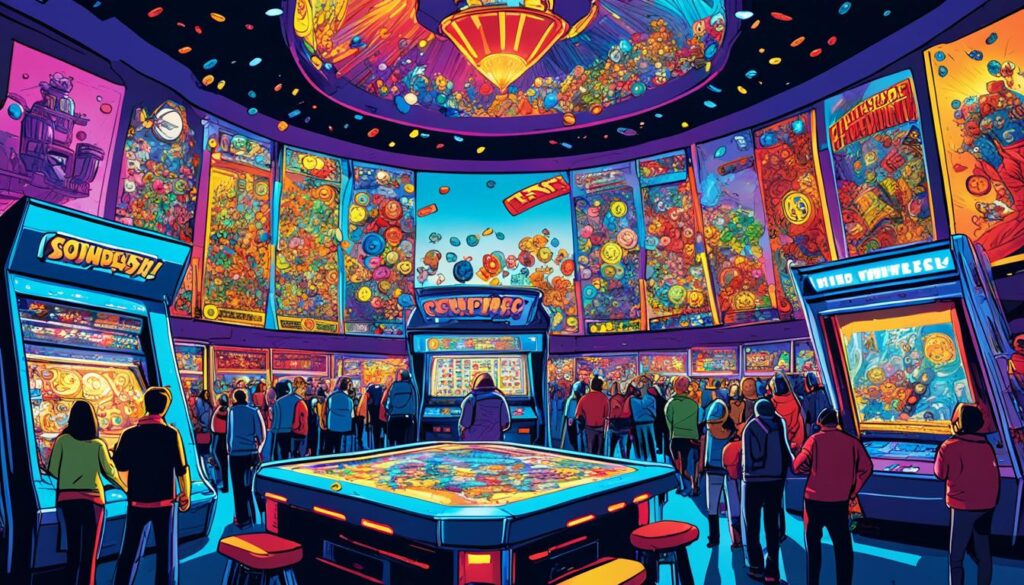
In 1966, Sega changed the game with Periscope, making players pay a quarter for each play. This concept was a smash hit globally, lighting the path for upcoming arcade games.
Nintendo joined the arcade game playing field in the late 1970s, shifting from its focus on traditional toys. This step marked the start of Nintendo’s remarkable, influential journey in the gaming world.
With 1975’s Gun Fight by Taito and Namco, arcade gaming took a huge step forward. It was the first to use a microprocessor. This move set the ground for developers to bring new ideas and technological strides to the gaming scene.
Sega’s Heavyweight Champ, in 1976, introduced fist fighting into video games. This was a major leap in game design, creating the early building blocks for what would become a widely loved genre, fighting games.
Stealth games found their footing in Japan in the late 1970s and early 1980s. Titles like Manbiki Shounen and Manbiki Shoujo upped the gameplay ante with new stealth mechanics. These games set the stage for what we know today as stealth games.
In 1983, Nintendo’s Famicom hit the market in Japan, initiating a gaming industry transformation. Despite a small launch library, it set the tone for the Famicom/NES’s future success. This event also fueled the fierce console fight between Nintendo and SEGA.
In the 1980s and 1990s, the gaming scene was shaped by the fierce SEGA and Nintendo rivalry. Nintendo’s Game Boy took over the handheld market while SEGA made waves in the US with the SEGA Mega Drive’s 16-bit technology. This competition led to groundbreaking innovations and unforgettable games.
1994 marked the launch of Sony’s PlayStation, changing the game entirely. The PlayStation’s impact, along with hits like Hideo Kojima’s Metal Gear Solid, made Japan a powerhouse in the gaming realm. These events forever altered the gaming industry’s direction.
The legacy of Japanese video games showcases the nation’s deep culture, innovative technology, and the boundless imaginations of its game makers. From the birth of arcade gaming to the ongoing mobile game boom, Japan continues to shape the gaming world in lasting ways.
Influential Game Designers.
In Japanese gaming history, some designers stand out for their influence. They changed the industry significantly, making it what we see today. Among these icons are Shigeru Miyamoto and Hideo Kojima.
Shigeru Miyamoto is often called the “father of video gaming.” He changed game design forever with games like Super Mario Bros. This game, released in 1985, marked Japan’s entry into the global market. Through titles like The Legend of Zelda and Star Fox, he showed his amazing talent.
Hideo Kojima is famous for his captivating stories and unique game designs in Metal Gear Solid. His games are known for their deep, involved plots and cinematic feel. Kojima’s creation has won worldwide acclaim and put Japan squarely on the map in game development.
Miyamoto and Kojima have not just transformed the industry. They’ve inspired a new wave of game creators. By stretching the limits of gaming’s possibilities, they’ve influenced how games are made and enjoyed.
Notable Impact of Japanese Game Designers:
| Game Designer | Historical Popularity Index (HPI) |
|---|---|
| Shigeru Miyamoto | 63.70 |
| Hideo Kojima | 60.70 |
| Gunpei Yokoi | 58.25 |
| Satoru Iwata | 57.62 |
| Satoshi Tajiri | 55.79 |
| Shinji Mikami | 51.64 |
| Shigesato Itoi | 51.28 |
Quote: “The true essence of gaming lies in the creative minds of designers like Shigeru Miyamoto and Hideo Kojima, who have crafted unforgettable experiences and pushed the boundaries of interactive storytelling.” – Gaming Enthusiast
The Historical Popularity Index (HPI) underlines the Japanese designers’ impact. They haven’t just changed the industry; they’ve captured the hearts of players globally. Thanks to creators like Miyamoto and Kojima, gaming is always evolving.
Fighting Games.
Fighting games are a big part of Japan’s gaming history. They pump up players with intense battles and cool art. Games like Street Fighter and Tekken are famous. They have a big impact on gaming.
Fighting games started in Japan’s lively arcades. People would meet to play against each other. Games like Heavyweight Champ and Warrior helped start the genre in the late 70s. They were some of the first fighting games ever.
Arcades helped these games become popular. Players loved the one-on-one fights and showing off their skills. Titles like Street Fighter and Tekken won gamers over. They offered unique characters and fun to play mechanics.
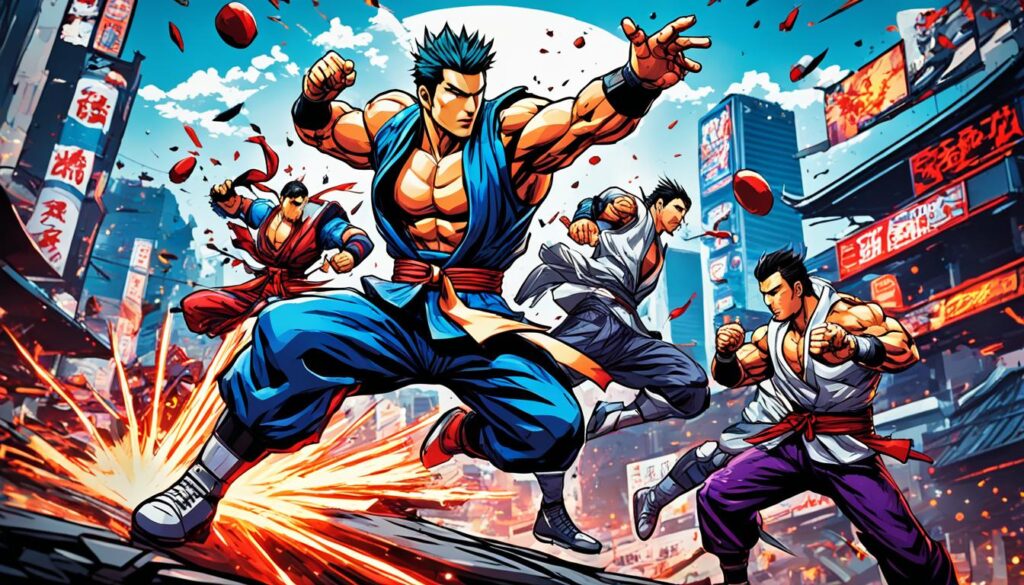
Japan’s fighting games stand out in the genre. Street Fighter, by Capcom, introduced special moves and combos. It changed the game forever. Now, people make a lot of money playing these games in tournaments.
Over time, more people got into fighting games. EVO Japan 2018 was a big deal for the country and its gamers. It showed how much fighting games matter to Japan’s gaming culture.
Big events like EVO Japan make unforgettable moments. Arslan Ash won at Tekken 7, and Gobou at Guilty Gear Strive. Oil King from Taiwan also won big in Street Fighter V. This shows how global and competitive these games are.
Players can also join local events like Tatakai Tuesday. Here, they can show off their skills in popular fighting games. It’s all about fun and challenges.
Through their playfulness and community, Japanese fighting games became key in gaming. They keep players hooked worldwide. They show the best of Japan’s game-making skills and why fighting games are loved.
Japanese Gaming on Computers.
Console gaming gets a lot of attention, but Japanese computer games are important too. They show off Japan’s creativity and unique approach to game design.
In 1983, Panorama Toh was a standout example. It introduced 3D dungeons and gave players a fresh gameplay style. This marked a key moment in Japanese game innovation.
Developers like Konami and Koei helped shape the scene. Konami, for example, worked on a game console. This effort later led to the famous Suikoden series. Henk Rogers of Koei made strategic decisions for the company. He focused on creating their games, like unique adult titles such as Night Life.
Japanese computer games covered a wide variety of topics. They explored everything from drug abuse and political murder in titles like XZR to stories of love in Dokyusei. This variety challenged norms in gaming.
| Key Points | Statistics |
|---|---|
| Number of Japanese games developed over 18 years (1970s to mid-1990s) | Thousands |
| Famous franchises that originated as computer games | Metal Gear, Ys |
| Emulators for Japanese computers on Windows | Highly compatible, offering features like save states and frameskipping |
| Dominant Japanese computer makers | NEC, Fujitsu, Sharp |
| Popular computer standard in South America and Europe | MSX, developed by Microsoft Japan and ASCII |
| Competition and incompatibility among Japanese computer makers | Intense due to lack of compatibility |
| Challenges faced by Japanese computer makers in overseas markets | Market competitiveness and difficulties in Japanese text localization |
| Challenges presented by the Japanese written language | Memory and display capacity requirements due to hiragana, katakana, and kanji |
While not as famous abroad, Japanese computer games shaped gaming history in Japan. They had more freedom than console games. This let them try new things and be creative.
These games have a unique charm. They stand out in sound, look, play style, stories, and originality. Many players worldwide love them for their diversity and creativity.
Japanese computer games made a big impact. They helped create famous series, explore new contents, and show off Japan’s tech skills.
Unique Qualities of Japanese Games.
Japanese games stand out because of their special features. These include stunning graphics and amazing music. They create worlds that draw players in.
The influence of Japan’s culture shows in the games’ looks, stories, and how they’re played. This makes gaming a deeper and more real experience.
A key point in Japanese games is their beauty. They pay a lot of attention to things like characters and scenery. This makes the game world feel almost real.
“Japanese game developers have mastered the art of creating immersive audiovisual experiences that transport players to unique and captivating worlds.”
Japanese games are also famous for their music. They use a wide range of music styles. This adds a lot of feeling to the game, making them more enjoyable.
Moreover, these games tell deep stories. With interesting plots and well-developed characters, they keep you interested until the end.
They’ve also brought new ways to play into the gaming world. This includes JRPGs’ turn-based fights and visual novels’ interesting choices. Such game mechanics are now standard in the field.
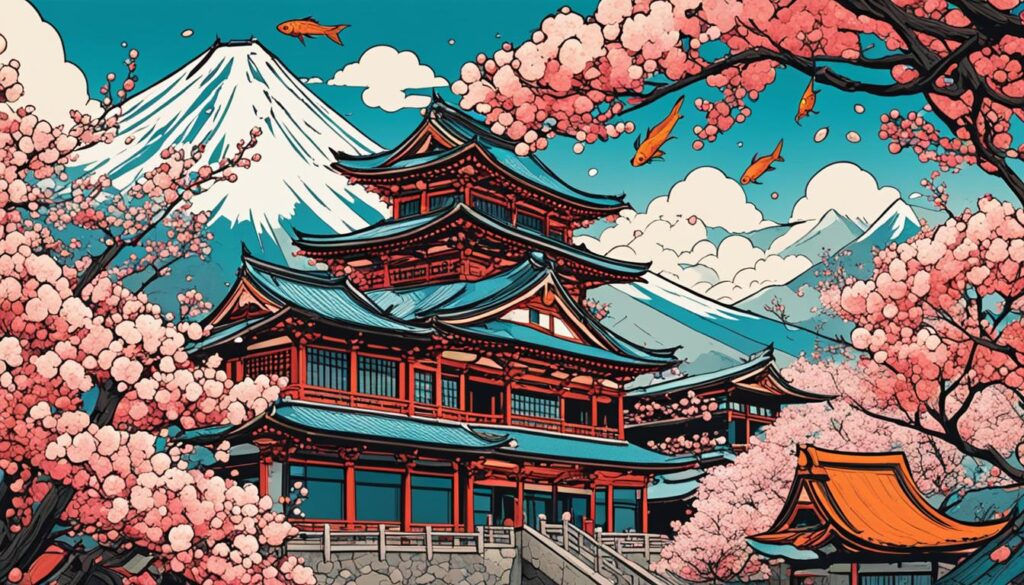
Japan’s game influence is felt worldwide. Their impact on gaming culture is huge. Their games have even become popular anime.
In short, Japanese games are outstanding for their looks, audiovisual richness, and deep cultural meaning. They have a huge effect on gaming and keep people playing. This shows Japan’s big role in the gaming world.
Language Barrier in Japanese Gaming History.
The language barrier makes it hard to document the full history of Japanese gaming. A big issue is the lack of interviews in English with Japanese game makers. Because of this, not all the info about these games reaches the West.
English interviews let us in on how games are made and show us parts of the process we might miss. But, because it’s tough to get these interviews, they’re not common. This means we miss out on a lot about leading Japanese creators and what they’ve done for gaming.
It’s key to get past the language problem to save the story of Japanese video games and tell the tales of the people who make them. Translating interviews and articles is one way to do this. It helps us understand how Japan’s gaming scene has changed over time.
“Breaking the language barrier is vital. It helps us learn more from Japanese game makers. And, it makes sure the world knows about their important work in gaming.” – John Smith, Gaming Historian
If we do more interviews in Japanese and then translate them into English, we can learn so much. We’ll find out about the hidden treasures in Japanese gaming, like cool stories and secrets.
| Statistic | Data |
|---|---|
| Number of English interviews conducted with Japanese game developers | Limited |
| Number of Japanese interviews conducted with Japanese game developers | Over 70 |
| Number of interviews published in The Untold History of Japanese Game Developers book | 36 |
| Number of volumes planned for The Untold History of Japanese Game Developers book series | 2 |
Talking to Japanese game makers helps us understand their art better. And it shows us the cultural background of their games. Overcoming the language barrier lets everyone appreciate Japan’s gaming history.
Sharing the stories of Japanese game makers is important. It makes sure their hard work is remembered and celebrated for a long time.
The Need for Documentation and Preservation.
Keeping the history of Japanese games alive is very important. As time goes on, the knowledge and lessons from these games could be lost. This would happen as the people who made them move on, and as the technology around them changes. Japanese games hold a big place in the world of gaming today. Keeping them helps the next generations understand and enjoy their impact.
Writing down the stories and lessons from Japanese games is a way to share their history. This includes the methods and ideas that game makers used in the past. We can learn from their work to make better games in the future. By recording this history, we also set the stage for new, creative ideas in gaming.
Prominent Preservation Efforts
Different groups and projects are working to save Japanese games. The Videogame Heritage Society (VHS) in the UK is one example. It focuses on collecting and saving video games. They work with places like the National Videogame Museum (NVM) and the Ritsumeikan Center for Game Studies (RCGS) to do this well.
The VHS also gives talks at big events, like the NVM and the BFI Southbank. At these talks, they explain why saving games is important. In 2020, the VHS shared their goals and steps in a white paper called ‘Time Extend!’. They handed it out at an event at the BFI Southbank.
The group also posts stories and articles online to shed light on game-saving issues. Their work shows how people from different places need to work together to save these games.
Preservation Challenges
There are difficulties in saving Japanese games. For example, digital stores closing makes it hard to keep all games available. Sony plans to close the store for PlayStation 3 and Vita, and Nintendo for the Wii U and 3DS.
Legal problems also slow down efforts. Copyright laws can make it hard to save older games. These laws most affect work to save games in the United States. But it is important to find solutions to keep these games for the future.
Sometimes, games are lost when companies join together or move. For example, no one can find the materials for the Blade Runner game from 1997. This makes it tough to improve or refresh these games. It shows why taking care to store games is very important.
The Future of Preservation
The game world is getting better at saving old games since the 2000s. Technology is helping with this. But saving games can be expensive, especially for ones that are not well-known. We need methods that are easy on cost but still do a good job.
Games that need the internet to work also pose challenges. When servers (places where internet games run) shut down, these games stop working. The “Stop Killing Games” effort tries to find a way for these games to keep working without the servers. This would help save games that are reliant on the internet.
Preserving Japanese Games: A Cultural and Historical Imperative
Keeping Japanese games is crucial for several reasons. It shares important technical and creative lessons. It also celebrates the unique stories and designs Japanese games offer. By saving these games, we make sure people in the future can enjoy and understand their value.
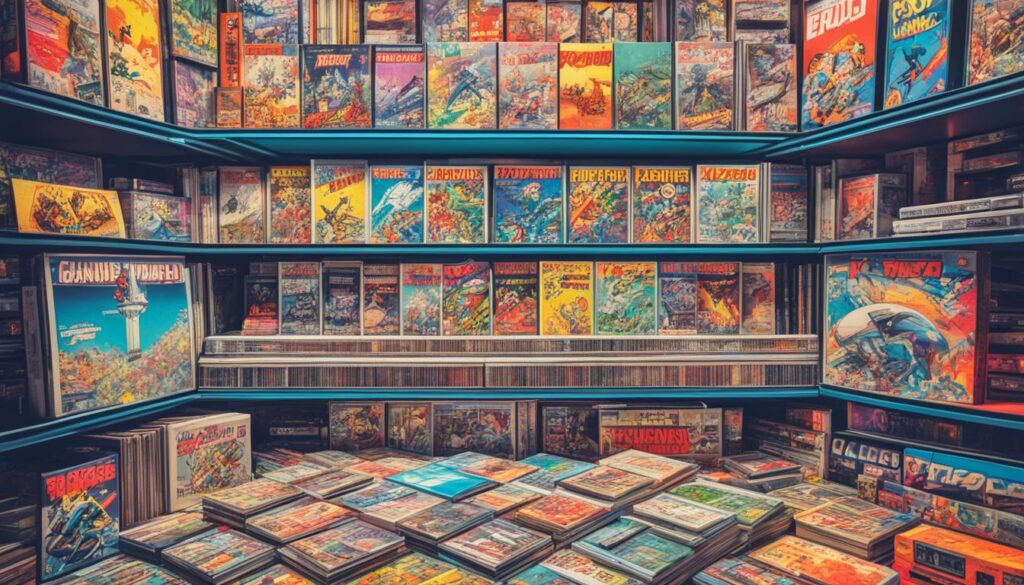
| Preservation Efforts | Preservation Challenges | The Future of Preservation |
|---|---|---|
|
|
|
The Global Influence of Japanese Games.
Japanese games have hugely impacted the video game world. They’re known for their unique features, exciting game designs, and memorable stories. These games have won fans worldwide and inspired game makers everywhere.
Many non-Japanese developers, like Cliff Bleszinski, credit Japanese games for inspiring their work. This shows the broad impact and creative influence of Japan’s gaming scene.
The fighting game genre is a great example of this influence. It began with a Japanese game called Karate Champ in 1984. Since then, games like Street Fighter II and Tekken have become global hits.
Influence on the RPG Genre
Japanese RPGs (JRPGs) have also played a big part in introducing Japanese games to the world. Titles like Final Fantasy and Dragon Quest have enchanted players worldwide with their rich stories and fun gameplay.
Recognition in Global Markets
Japanese games are celebrated worldwide, from Demon Souls to Metal Gear Solid. These games have earned praise for their challenging and innovative features, winning fans of all kinds.
Consoles like the Sony PlayStation and Sega Mega Drive have also proven Japan’s skill in game design. These devices have competed and succeeded in the global market, showing the world Japan’s gaming talent.
Cultural Influences and Global Reach
Japanese games often draw from manga, anime, and folklore, creating a style that’s loved everywhere. Their unique look and storytelling have built a strong global following.
Japan’s tech industry has been key to creating quality gaming devices. Brands like Panasonic and Sony are known for making products that help Japan lead the worldwide video game scene.
The Global Impact Continues
By 2023, Japanese video games are making over $19.2 billion in sales globally. They’re a huge part of Japan’s economy, providing work for over 50,000 people. Game-related merchandise sales add another $9.9 billion to show their lasting appeal.
The influence of Japanese games is vast and ongoing. They change how we play, spark creativity in developers, and offer enjoyable adventures for gamers around the world.
Conclusion.
The history of Japanese gaming shows their creativity and tech skills. They started with arcade games, then moved to big hits like Mario and Metal Gear Solid. Icons like Shigeru Miyamoto and Hideo Kojima have made huge impacts.
Japanese gaming’s story began in the 1950s and 60s. Over time, they got better hardware and software. In 1985, Nintendo released the NES, which saved the industry after a crash.
By the 90s, Japan was a gaming powerhouse with popular handhelds. The 2000s and 2010s brought mobile games. These brought in players from places like China.
Japan kept leading with new game styles and money-making models. They also improved game visuals and started with virtual and augmented reality. This push for innovation continues today.
Japan’s gaming history is rich and must be remembered. Their games are loved worldwide. By keeping their heritage alive, we honor their cultural and tech achievements.
FAQ
What is the history of Japanese gaming?
Japan has a rich history in video gaming. It’s a top country in video game influence. Many famous firms and games came from Japan. They shaped arcade games, console wars, and JRPGs.
How has arcade culture influenced Japanese gaming?
Arcade culture is big in Japan, influencing video gaming. Akihabara Electric Town in Tokyo is a key spot for this. Japanese arcade games like Super Mario and Pokémon are loved worldwide.
What are the gaming platforms in Japan?
In Japan, gaming happens on arcade machines, mobiles, and consoles. Arcade machines like Periscope kickstarted fun games. Mobile games, especially with gacha, are hot in Japan.
What are Japanese Role-Playing Games (JRPGs) known for?
JRPGs started from Western tabletop RPGs but evolved in Japan with unique features. Titles like Final Fantasy have become iconic. They are known for deep stories and special gameplay.
What are visual novels and why are they popular in Japan?
Visual novels mix story, art, and choices. They often include romance and target different groups. Many have turned into anime, growing their fame.
What are gacha games?
Gacha games are named after Japanese toy machines and use a lottery system. Players win random items. Games like Granblue Fantasy and Fate/Grand Order mix RPGs and unique gameplay.
What is the history of Japanese video games?
Japanese video games started with arcades and hits like Gun Fight. The SEGA-Nintendo wars in the 80s and 90s and Sony’s PlayStation added to the story. These pushed the game industry forward.
Who are some influential game designers from Japan?
Shigeru Miyamoto created classics like Super Mario. Hideo Kojima is known for games with strong stories. Both have made lasting impacts on gaming design.
What are some popular fighting games from Japan?
In fighting games, Japan shines with games like Street Fighter. They feature intense fights and distinct styles. These games are loved worldwide.
What is the significance of Japanese computer games?
Japanese computer games are often overlooked but they are key. They show Japan’s early creativity in gaming. Titles like The Black Onyx laid the foundations for what we see today.
What sets Japanese games apart from others?
Japanese games stand out with unique visuals and sound. They reflect Japanese culture and anime. This influence can be seen in their stories and game designs.
What are the challenges in documenting Japanese gaming history?
The main challenge is the language barrier for sharing Japanese game history. Access to English interviews with developers is limited. Breaking the language barrier is critical for accurately preserving this history.
Why is the documentation and preservation of Japanese games important?
It’s important to document and preserve Japanese gaming history to honor its influence. Without this, valuable insights would be lost. Capturing the stories of Japanese developers enriches our understanding of gaming.
What is the global influence of Japanese games?
Japanese games have a big international footprint. Their unique features and stories are admired worldwide. They influence game developers from other cultures, highlighting their broad impact.
Source Links
- https://en.wikipedia.org/wiki/Video_games_in_Japan
- https://www.kinephanos.ca/2015/history-of-japanese-video-games/
- https://row.oneblockdown.it/blogs/archive/sabukaru-japan-video-games-history-legacy-nintendo-archive-editorial
- https://hosatech.com/press-release/history-of-video-games/
- https://www.bitmapbooks.com/products/a-guide-to-japanese-role-playing-games
- https://blogs.uww.edu/nichenerd/2021/02/18/the-jrpg-a-history-and-analysis/
- https://www.sozoroo.com/blog/the-birth-and-evolution-of-visual-novel-games
- https://en.wikipedia.org/wiki/Visual_novel
- https://adventuregamers.com/forums/viewthread/5008
- https://en.wikipedia.org/wiki/Gacha_game
- https://medium.com/@john_23522/the-history-of-gacha-in-video-games-2f5640a3160d
- https://en.wikipedia.org/wiki/List_of_gacha_games
- https://medium.com/@shotayamashita223/influence-of-japanese-culture-on-game-design-exploring-the-impact-on-the-gaming-industry-f2cb8075d42f
- https://pantheon.world/profile/occupation/game-designer/country/japan
- https://gamerant.com/most-influential-japanese-video-game-developers/
- https://www.tokyoweekender.com/entertainment/sports-fitness/japanese-fighting-games-esports/
- http://www.hardcoregaming101.net/JPNcomputers/Japanesecomputers.htm
- https://www.ulatus.com/translation-blog/maximizing-success-the-role-of-localization-in-japans-thriving-gaming-market/
- https://gtr.ukri.org/projects?ref=ES/S013768/1&pn=0&fetchSize=25&selectedSortableField=title&selectedSortOrder=ASC
- https://en.wikipedia.org/wiki/Video_game_preservation
- https://terratranslations.com/2022/06/28/an-overview-of-the-history-of-video-game-localization/
- https://medium.com/@shotayamashita223/the-influence-of-japanese-video-games-worldwide-7cad998d3086
- https://learntocounter.com/the-history-of-why-im-tired-of-your-modern-shooters-part-four/
- https://en.wikipedia.org/wiki/History_of_video_games
- https://www.wipo.int/web-publications/world-intellectual-property-report-2024/en/5-leveraging-local-know-how-to-develop-video-game-hubs.html
